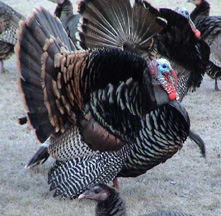



 The Accurate Reloading Forums
The Accurate Reloading Forums  THE ACCURATE RELOADING.COM FORUMS
THE ACCURATE RELOADING.COM FORUMS  Hunting
Hunting  American Big Game Hunting
American Big Game Hunting  Lyme Again
Lyme AgainGo  | New  | Find  | Notify  | Tools  | Reply  |  |
| one of us |
May 2015 is Lyme Awareness Month in USA and Canada [maybe worldwide] finally maybe some good action ! http://lymedisease.biz www.canlyme.com www.lymenet.org www.lymeinfo.netwww.lymedoctor.com Spread the word ! as Lyme is certainly spreading ! | ||
|
| One of Us |
Almost unbelievable that there's not a vaccine against Lyme as yet. There was for a short period of time but it wasn't 100% effective and the company was sued after someone had a complication so they took it off the market. Lyme is near epidemic in the northeast. | |||
|
| One of Us |
I remember that vaccine. It was a series of 3 shots. I got two then it was taken off the market. I hope I'm 2/3 protected. Tom Z NRA Life Member | |||
|
| one of us |
Our little biting friends actually offer a smorgasbord of horrifying pathogens: http://www.cdc.gov/ticks/diseases/ There is hope, even when your brain tells you there isn’t. – John Green, author | |||
|
| One of Us |
The vaccines were only taken off the market in America. You should still be able to be treated for it in Canada. Cheapest trip you'll ever make to get those vaccines. | |||
|
| One of Us |
they took it off the market because the vaccine masked the symptoms and you could still get the disease, but not know it | |||
|
| One of Us |
Vaccines Background Two large pharmaceutical companies have devoted considerable effort to developing a vaccine for Lyme disease, but there are no vaccines for humans available in the United States today. Double-blind, randomized, placebo-controlled clinical trials—the most rigorous type of clinical trial used today— have been completed for each of two Borrelia burgdorferi vaccines manufactured by GlaxoSmithKline [(GSK), formerly SmithKline Beecham (SKB)], and Pasteur Merieux Connaught. Each study involved more than 10,000 volunteers from areas of the United States where Lyme disease is common. Both vaccines were based on a specific part of B. burgdorferi called outer surface protein A (OspA). They were found to be between 49 and 68 percent effective in preventing Lyme disease after two injections, and 76 to 92 percent effective in preventing Lyme disease after three injections. The duration of the protective immunity generated in response to the vaccines is not known. The SKB vaccine was ultimately licensed as LYMErix and approved by the Food and Drug Administration (FDA) in December 1998. NIAID was not directly involved in the design and implementation of these particular vaccine trials. However, patents for cloning the genes used in making the vaccine, as well as knowledge of how certain antibodies contribute to protective immunity, were derived from basic research grants funded by NIAID. In April 2002, GSK announced that even with the incidence of Lyme disease continuing to rise, sales for LYMErix declined from about 1.5 million doses in 1999 to a projected 10,000 doses in 2002. Although studies conducted by FDA failed to reveal that any reported adverse events were vaccine-associated, GSK discontinued manufacturing the vaccine (Vaccine 20: 1603, 2002). In 2013, Baxter Biosciences (Vienna, Austria) reported the development and clinical testing of a new multivalent vaccine for Lyme disease in humans (Lancet Infect Dis 13: 680, 2013). NIAID Research Reservoir-based approaches Infectious disease reservoirs are what scientists call the places or populations that harbor disease-causing pathogens. For example, certain types of wildlife can be long-term carriers, or hosts, of a disease. Rodents are a major reservoir for Lyme disease, so scientists have been looking at ways to prevent them from getting infected with B. burgdorferi. Stopping the bacterial infection in rodents could potentially prevent transmission of the bacteria to the ticks that depend on the rodents in their early life cycle, and, therefore, from ticks to humans. NIAID-funded investigators have developed an experimental bait—and vaccine—delivery system. In a study, mice were given this vaccine-laced bait then exposed to Ixodes ticks carrying multiple strains of B. burgdorferi. Oral vaccination was found to protect 89 percent of the mice from infection and the blood tests showed their immune systems created antibodies to the Lyme bacteria (Clin Vaccine Immunol 18: 1809, 2011). NIAID is part of a collaborative effort with researchers at Ventria Bioscience and the Centers for Disease Control and Prevention who are supporting a similar approach. Scientists are working to grow rice plants that contain vaccine elements that could eventually be fed to rodent populations, thus blocking the transmission cycle of the disease from rodents to ticks to people. These findings are consistent with the results reported by other investigators (Proc Natl Acad Sci 52: 18159, 2004). In other studies, NIAID grantees have developed a mouse-targeted vaccine using Vaccinia virus. Oral vaccination of mice with a single dose of the vaccine resulted in strong immune system response and full protection from B. burgdorferi infection among vaccinated mice. In addition, scientists observed a significant clearance of B. burgdorferi from infected ticks who fed on vaccinated mice (Vaccine 24: 1949, 2006). These findings indicate that such a vaccine may effectively reduce the incidence of Lyme disease in endemic areas. Human Vaccine Development NIAID supports significant research efforts focused on human vaccination against Lyme disease. Ongoing research projects include the development of a new, second-generation vaccine for human Lyme disease; studies to test the vaccine in mice are underway. NIAID also supports multiple research projects in early-stage discovery and characterization of novel vaccine targets, including tick saliva-based approaches. http://www.niaid.nih.gov/topic...h/Pages/vaccine.aspx | |||
|
| One of Us |
I lucked out with Lyme. I got it in 2007, and figured it out quick enough to get on an anti-biotic regime and get over it. The VA says I still have the antibodies in my blood, and they claim I should not have any problems from it. I don't believe them but we will see. | |||
|
| one of us |
Some others to consider . . . CDC - Tickborne Diseases of the U.S. - Ticks http://www.cdc.gov/ticks/diseases/ Don't limit your challenges . . . Challenge your limits | |||
|
| One of Us |
For the last 10 years I have used a 1% Permethrin solution that I spray on my clothes that I wear in the woods. I spray the clothes really well then hang them to let then dry and let the odor dissipate. It works really well. Do NOT spray the Permethrin on your skin. I find that the effects of the spray last even after a few washings (your mileage may vary). I first tested it years ago during Spring turkey season. I sprayed my hunting clothes with Permethrin 1% my buddy did not. We hunted together and he had several ticks on him and I had none. I think prevention is the best course when it come to tick borne diseases. | |||
|
| one of us |
Beware of the insecticides like permethrin !! Use it sparingly , never on skin .It can be absorbed and go into a fetis !! It's one of the chemicals that has been found in kids with autism ! Washing clothing does not harm Lyme but a trip through the dryer at high temps for 10-15 minutes does. | |||
|
| One of Us |
Propaganda BS. Use it on your clothes and gear, avoid getting it on your skin. Above all, don't listen to idiocy like the crap in the quoted post. | |||
|
| One of Us |
I live pretty close to the epicenter when it comes to Lyme disease. Permethrin is the way to go for me. Works like a charm. Phil Life Member- NRA & SCI | |||
|
| one of us |
Missed these last posts but -- here is the study of permethren/autism connection . http://www.sciencedaily.com/re.../06/140623092930.htm I have no other source at the moment. | |||
|
| One of Us |
Bear in mind that a significant portion of studies from even the most prestigious publications are not reproducible. I'm not talking about 10-15% either. Until a study has been scrutinized and reproduced independently, be moderate in how you let it guide your actions. Economist article analog_peninsula ----------------------- It takes character to withstand the rigors of indolence. | |||
|
| One of Us |
Here's hoping that the lawyer who filed the lawsuit gets Lyme disease. Back when the human Lyme vaccine first came out I got a shot, and then a booster the second year, I think. They discontinued the vaccine shortly thereafter. What is interesting to me is that there probably isn't anyone in south central Pennsylvania who spends a whole lot more time outdoors than I do. I pick ticks off myself on an almost daily basis, and I'm sure that I have had a few that embedded and I missed them, yet I have not contracted Lyme disease. My sawbones says it is probably because I am one of the ones the vaccine worked for. Perhaps it makes no sense to vaccinate people with a not totally perfect vaccine, but I'm convinced I have benefitted from that imperfect vaccine. Being the cynic that I am, I have to wonder if the pharmaceutical industry doesn't make more money selling the antibiotics to treat Lyme disease than it would if it developed an effective vaccine. Most of my money I spent on hunting and fishing. The rest I just wasted | |||
|
| Powered by Social Strata |
| Please Wait. Your request is being processed... |
|

Visit our on-line store for AR Memorabilia

